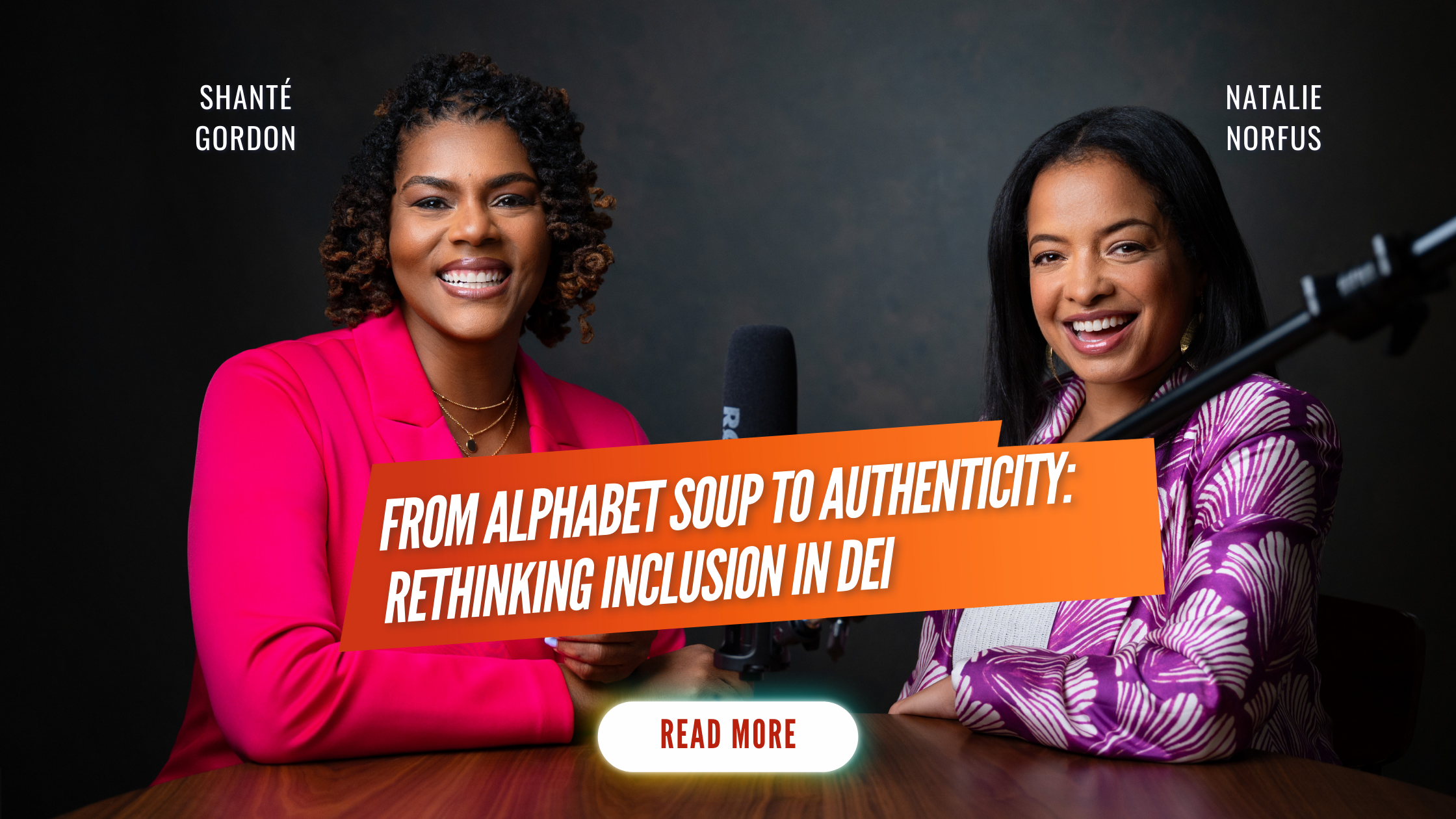From Alphabet Soup to Authenticity: Rethinking Inclusion in DEI

Natalie and Shanté confront one of the most pervasive challenges facing leaders today: how to navigate the murky waters of DEI rollbacks and external political pressure while continuing to lead with integrity and inclusivity. As legal battles unfold and headlines swirl, it can feel like inclusive leadership is under siege—but Natalie and Shanté are here to remind us that this is precisely the time for leaders to lean in.
At the heart of this conversation is a timely message: leadership in 2025 requires resilience, clarity, and the courage to rise above the noise.
Why Leaders are Hesitating in 2025
The episode opens with a candid reflection on why many organizations are pulling back on DEI. From fear of litigation to social and political pressure, leaders are navigating external forces that make DEI feel like a minefield. But Natalie and Shanté emphasize that leaders must resist knee-jerk reactions driven by misinformation as the panic stems from a misunderstanding of what DEI actually is. DEI is not a political hot potato—it’s a set of strategies rooted in fairness, belonging, and innovation. The episode highlights that pulling back on DEI sends a ripple effect through organizations, leading to disengaged employees, brand damage, and long-term business risks.
Leading in the “Gray Area”
Natalie and Shanté dive deep into the ambiguity leaders now face. When faced with unclear or shifting directives—whether from executives, boards, or external actors—leaders must find ways to create certainty for their teams. “Gray areas” in leadership are inevitable, but they don’t mean inaction is the answer. Instead, leaders must act as buffers, helping their teams navigate uncertainty without falling into paralysis.
The Power of the LEAD Framework
The hosts introduce the LEAD Framework—a four-step model for taking action and maintaining inclusive leadership despite the noise:
- L – Listen: Leaders must start by listening deeply to their teams. What are employees worried about? Where is confusion stemming from? What are they experiencing day to day? Listening creates trust and helps leaders accurately diagnose issues, rather than making assumptions.
- E – Evaluate: Next, leaders need to gather data—both qualitative and quantitative. Beyond engagement surveys, leaders should pay attention to turnover trends, promotion rates, and informal feedback loops. Evaluation helps leaders spot patterns, blind spots, and simmering issues.
- A – Align: After gathering insights, it’s critical to align leadership behaviors and decisions with the organization’s values and goals. This might mean standing firm on certain DEI initiatives even when external pressures mount, or clearly articulating to employees how inclusion connects to business success.
- D – Deliver: Finally, leaders must execute. Small wins count here. Delivering on promises, communicating progress regularly, and celebrating milestones keeps teams motivated and focused.
Natalie and Shanté emphasize that this framework is not just a checklist—it’s an ongoing process. Inclusive leadership is iterative and requires leaders to circle back through these steps regularly as circumstances evolve.
Why Transparency Builds Trust
A key insight from this episode is the role of transparency. In times of uncertainty, employees look to leadership for cues. Silence or vague statements create anxiety, while honest communication—even when leaders don’t have all the answers—builds trust.
Natalie shares a reminder that trust is earned over time, but it can also be eroded quickly. Leaders who regularly share progress updates, openly acknowledge challenges, and provide context for tough decisions create an environment where employees feel psychologically safe, even amid chaos.
The Real Cost of Rushed Decisions
Shanté cautions leaders against the temptation to move too quickly in response to external pressures. Speed without strategy leads to wasted resources, missed opportunities, and potential harm to employee morale. Leaders must instead “slow down to speed up,” ensuring that their actions are thoughtful and aligned with the long-term wellbeing of their people and the business.
Leaning on Partnerships and Allies
One of the most actionable takeaways from this conversation is the importance of partnerships. Whether collaborating with HR, legal, or external consultants, leaders should avoid trying to tackle inclusion challenges alone. The episode encourages leaders to build coalitions within their organizations to pressure-test ideas, troubleshoot challenges, and hold one another accountable.
What’s Next for Inclusive Leadership
As the episode wraps, Natalie and Shanté point out that DEI isn’t disappearing—it’s evolving. Organizations that take this moment to refine their DEI strategies, rather than retreat from them, will ultimately emerge stronger.
The episode ends with a call to action: now is the time for leaders to dig deep, recommit to their values, and use frameworks like LEAD to provide clarity and direction for their teams.
Key Takeaways
- The current climate requires leaders to be steady, transparent, and data-driven.
- Inclusive leadership is not optional; it’s a necessity for business success and employee wellbeing.
- The LEAD Framework (Listen, Evaluate, Align, Deliver) offers a practical roadmap to maintain inclusive practices amid uncertainty.
- Slowing down, staying rooted in values, and leaning on partnerships can prevent costly missteps.
Connect With Us
If you found this discussion compelling, we invite you to connect with us further. Here are some ways to stay in touch:
- Follow Natalie Norfus on LinkedIn
- Follow Shanté Gordon on LinkedIn
- Book a consultation with The Norfus Firm
- Follow What’s the DEIL on Instagram and TikTok
